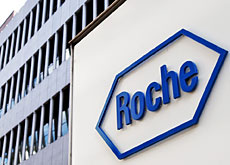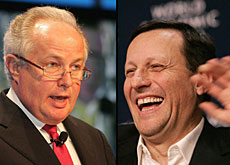Roche holds edge in battle of giants

Roche's outstanding performance in recent years and a stronger drugs portfolio give them an advantage over pharmaceutical rivals Novartis, an expert tells swissinfo.
Both Basel firms turned in strong results last year, with Roche profits soaring 34 per cent to SFr9.2 billion ($7.3 billion) and Novartis announcing a 17 per cent rise to SFr9 billion.
As the two companies go from strength to strength and outperform the international market it is hard to judge which holds the stronger position. Bank Vontobel analyst Karl-Heinz Koch tips Roche to keep its slight advantage in the long term.
Koch’s verdict is influenced mainly by Roche’s current crop of highly profitable cancer treatments, including Herceptin and Avastin, that will remain under patent protection for some years to come.
Novartis has a highly diversified range of drugs about to hit the market, but Koch believes Roche will pack the bigger punch for the time being thanks to higher profits from existing products.
“In terms of growth the two companies will become more comparable going forward. Novartis has a broader and more advanced pipeline than Roche and that could help them to outgrow the industry and to catch up, or even exceed, the growth of Roche,” Koch said.
“But although Novartis is catching up in terms of top line momentum, in terms of profitability leverage going forward I would still expect Roche to have more power in the medium and long term.”
Five years ago Roche was the sick man of the European pharmaceutical sector after a series of product setbacks. But largely thanks to a productive collaboration with its US-based daughter biotech company Genentech, Roche steadily climbed its way clear of trouble.
Global strength
The spectacular comeback was further boosted by prolific sales of influenza drug Tamiflu, sparked by the widespread outbreak of bird flu.
Novartis took full advantage of the Roche crisis to claim pole position as Switzerland’s most successful pharmaceutical giant. Healthcare analysts IMS Health rated Novartis as the fourth best performer worldwide last year in terms of pharmaceutical sales, with Roche in eighth place.
Novartis became the world’s biggest producer of generic drugs when it bought Germany’s Hexal and US-based Eon Labs in 2005. It completed the buyout of vaccine maker Chiron a year later. There was even enough spare cash before then to take a third stake in Roche.
However, the spreading of Novartis’ interests has not gone down well in some quarters, according to Koch.
“The market likes the more focussed strategy of Roche better and views Novartis as too diversified. The generics market is an area that holds a lot of promise for future growth, but it lacks visibility and profitability is much lower,” he said.
Both companies appear well placed to take advantage of any slip-ups from international rivals. Some large pharmaceuticals, notably industry leader Pfizer, have run into problems recently by relying too much on existing blockbuster products without filling their pipeline.
“Novartis and Roche are both outperforming the international peer group, but the rest of the sector has done a lot of work to bridge their product gaps and sustain growth,” Koch said.
“The industry as a whole is looking a bit shaky at the moment but the players are well aware of the problems and are doing what they can to overcome those difficulties.”
swissinfo, Matthew Allen
Roche 2006 results:
Net profit: SFr9.17 billion
Full-year sales: SFr42.04 billion
Operating profit: SFr11.73 billion
Novartis 2006 results:
Net profit: $7.20 billion
Full-year sales: $37.02 billion
Operating income: $8.2 billion
Roche, which was founded in 1896 in Basel, has core businesses in pharmaceuticals and diagnostics.
The group is the number one in the global diagnostics markets and is a leading supplier of medicines for cancer and transplantation.
Created in 1996 through the merger of Ciba-Geigy and Sandoz, Novartis is currently organized into four divisions.
These are Pharmaceuticals (prescription medicines); Vaccines and Diagnostics, a new division focused on the development of preventive treatments and tools; Sandoz, (generic prescription drugs) and Consumer Health.
The name Novartis is derived from the Latin novae artes, meaning “new skills” and is intended to reflect the company’s commitment to research and development.

In compliance with the JTI standards
More: SWI swissinfo.ch certified by the Journalism Trust Initiative



You can find an overview of ongoing debates with our journalists here. Please join us!
If you want to start a conversation about a topic raised in this article or want to report factual errors, email us at english@swissinfo.ch.